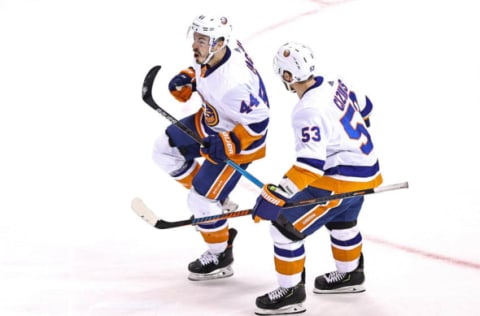Islanders: Three Takeaways from 4-1 Game Four Win


The New York Islanders needed to have a big answer against the Pittsburgh Penguins in game four to avoid going down 3-1 in the series.
Having gone down two games to one in their opening-round playoff series with the Penguins, the New York Islanders needed to have a big answer on home ice in game four. They got that answer and beat Penguins goalie Tristan Jarry four times on 26 shots on goal to win 4-1 in front of a raucous Nassau Coliseum crowd.
Here are three takeaways from the big win and return to form performance.
1. Sorokin’s Solid but Unspectacular Performance
I call Ilya Sorokin’s performance unspectacular simply based on the fact that his teammates didn’t make him work extremely hard. Sorokin faced 30 shots on goal and turned aside 29 of those of course, but by and large, the chances Pittsburgh had against Ilya were not of a particularly scary nature.
While a one-goal, 29-save performance is very solid, diving deeper into the numbers makes clear that Sorokin’s day was a fair bit easier than Jarry’s. Sorokin faced only six high-danger shots against*, and turned aside five of them. He stopped all 23 medium-to-low danger shots faced.
On the other end, Tristan Jarry faced 12 high-danger shots against, saved eight of them, and also turned aside all medium-to-low danger shots against.
* High, Medium, & Low-Danger shot totals courtesy of Natural Stat Trick
Sorokin saved 1.03 goals above expected (GSAx) on 2.03 expected goals against (xGA) in all situations. While those numbers don’t jump off the page, they’re a refreshing regression back to where Islanders goaltending is expected to be.
Semyon Varlamov allowed five goals on 2.19 xGA in all situations in Thursday’s game three loss, a stark departure from the veteran NHL’er’s great run of form in the 2020 bubble playoffs and 2020-21 regular season.
Sorokin in game four didn’t have to have a show-stopping performance. He made the saves you’d expect him to, and he just played within himself. The Islanders strong defensive performance kept the Penguins away from the front of his net for the most part and allowed him to do that.
That said, there were a few memorable saves made by Ilya on the day. His early save on Kasperi Kapanen, who had beaten Scott Mayfield to an inside lane in the neutral zone and raced in on net off a pass by Evgeni Malkin, felt like another moment in which the Islanders could’ve surrendered an early goal. Only they didn’t, thanks to Sorokin’s blocker.
Later, Sorokin denied Sidney Crosby by tracking the Penguins captain all the way across his crease to deny an in-tight opportunity.
So Sorokin’s play-in game four wasn’t spectacular, but it was good enough to win, just as it was in game one. While I made the argument that Semyon Varlamov wasn’t the Islanders problem in game two, he certainly was a big part of it in game three, and in game four Sorokin was part of the solution. His work on Saturday afternoon should earn the young Russian a game five start.

2. Wahlstrom’s First-Ever NHL Playoff Goal
Oliver Wahlstrom has had a bit of an up and down first NHL playoff series. He was a key cog in the Islanders third line’s strong game one performance but had seen difficulties in replicating that performance in games two and three. He was an impact performer again in game four, and that saw him score his first-ever NHL playoff goal.
Wahlstrom’s game three tally wasn’t necessarily the product of his beautiful shot. Instead, it was a goal owed mostly to Penguins center Teddy Blueger, who knocked the loose puck off of Wahlstrom’s shot into the Pittsburgh net.
That, however, isn’t an indictment of Wahlstrom’s performance. The young winger assisted earlier on Ryan Pulock’s goal, another redirection off a Penguin, Cody Ceci, whose skate the Pulock blast hit before finding the back of the Penguins net.
Wahlly finished tied for third among Islanders skaters with four individual shot attempts (iCF) and individual scoring chances for (iSCF). He also drew a penalty late in the second period which sent Malkin to the penalty box for the third time on the day.
Wahlstrom’s performance isn’t likely to turn any heads just yet, but his two points and heady play, as well as his continued commitment to not shying away from the physical side of his game should shine through for Islanders fans looking for an impact player in the Islanders bottom-six forward group.
Of course, the goal could also serve as a spark to ignite Wahlstrom’s confidence. Don’t forget Wahlly’s first NHL regular-season goal came as a result of an odd bounce that helped the puck find its way on net. It’s hard to say Wahlstrom’s mid-season goal-scoring exploits were aided by that first lucky bounce, as they came almost a month apart, but it certainly couldn’t have hurt either.
Wahlstrom’s shot totals began to spike in February and mid-March as the player gained confidence, and that is the sort of thing the Islanders could use going forward. Hopefully, Wahlstrom’s first playoff goal can give way to those kinds of aggressive, goal-hunting performances by the youngster.

3. Islanders Strong on Faceoffs, Forecheck
The glutton of center talent on this New York Islanders team is part of what makes them so hard to play against. Brock Nelson, J-G Pageau, and Casey Cizikas are a fearsome trio to line up across from at the dots, and that showed through on Saturday at the Coli.
Nelson, Pageau, and Cizikas went a combined 28-15 at the faceoff dot in game four. Mathew Barzal, Leo Komarov, and Josh Bailey, the three other Islanders to take draws in the game, were a combined 5-2.
Sidney Crosby finished 6-12 on faceoffs while lining up primarily against Nelson. Jeff Carter went 6-9 facing off against Mathew Barzal and J-G Pageau. Teddy Blueger faced a combination of Pageau and Nelson and finished for 4-for-10 at the dot.
Evgeni Malkin, whose skin the Islanders were getting under all game long, finished his day 1-for-5 in the faceoff circle. Malkin lined up against Casey Cizikas for most of the day and had little success in finding ways to beat Casey in draws.
The faceoff successes are what Islanders fans envisioned when the team acquired Pageau and further stacked their center corps. Talks about what a strong team down the middle they would be when healthy have come to fruition.
But, more importantly, the Islanders forechecking returned in game four. Their forecheck had been mostly shredded by Pittsburgh’s slick puck-moving previously in this series, but on Saturday the Isles were a tight-checking, disciplined team who played well positionally to take away outlets and exit lanes.
That is the most crucial part of the Islanders gameplan. When they are playing well, it’s because they are giving opposing defensemen very little time to coordinate defensive zone exits, causing turnovers, and using their cycling to generate O-zone time.
We hadn’t seen enough of that in games one, two, or three, but we did in game four, and it will be important to keep that effort rolling into game five.
A lot of people continue to spread the false narrative that the 2020-21 Islanders were not a strong possession or analytics team. In fact, for three-quarters of the season, the opposite was true. The Islanders were a top-five team in xGF% between January 11 and April 1, and a big part of that was a strong cycle aided by dogged forechecking efforts.
If they are to take this series away from the Penguins, the best way to do so will be by forechecking, plugging gaps, and grinding down the opposition’s defense. It has driven this team to this point and will have to continue doing so through this opening round of the playoffs and beyond for the Islanders to find more postseason success.